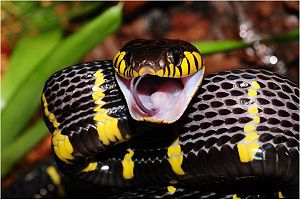Sandbox Reserved 932
From Proteopedia
| Line 51: | Line 51: | ||
===Conclusions=== | ===Conclusions=== | ||
| - | 3FTXs are the most abundant and well characterized snake venom protein family. The broad spectrum of 3FTX targets, including nAChRs, phospholipids and L-type calcium channels, make the proteins interesting for research. The interaction of 3FTX-proteins with their targets result in a myriad of pharmacological effects. Study of the 3FTX family proteins can also be utilised in the research of their receptors. Understanding how the architecture of the proteins of the family result in the varying mechanisms of action can prove a valuable tool for rational drug design. | + | 3FTXs are the most abundant and well characterized snake venom protein family. The broad spectrum of 3FTX targets, including nAChRs, phospholipids and L-type calcium channels, make the proteins interesting for research. <ref name=Pawlak/> The interaction of 3FTX-proteins with their targets result in a myriad of pharmacological effects. Study of the 3FTX family proteins can also be utilised in the research of their receptors. Understanding how the architecture of the proteins of the family result in the varying mechanisms of action can prove a valuable tool for rational drug design. |
Whilst the highly conserved three finger structural motif is present in denmotoxin minor structural differences can be found when compared to other proteins of the family. These differences are responsible for the recognition of target receptors and can modulate both the specificity and toxicity of the venom. | Whilst the highly conserved three finger structural motif is present in denmotoxin minor structural differences can be found when compared to other proteins of the family. These differences are responsible for the recognition of target receptors and can modulate both the specificity and toxicity of the venom. | ||
Revision as of 15:12, 18 May 2014
| This Sandbox is Reserved from 01/04/2014, through 30/06/2014 for use in the course "510042. Protein structure, function and folding" taught by Prof Adrian Goldman, Tommi Kajander, Taru Meri, Konstantin Kogan and Juho Kellosalo at the University of Helsinki. This reservation includes Sandbox Reserved 923 through Sandbox Reserved 947. |
To get started:
More help: Help:Editing |
B. Dendrophila monomeric toxin (Denmotoxin) is the primary protein of snake venom used by Boiga dendrophila (fig. 1). This colubrid snake lives in Southest Asian lowland rainforest and mangrove swamps using birds as its primary prey. It belongs to one of the most well characterized snake venom protein families is the Three-finger-toxins (3FTX). These proteins consist of three β-stranded finger-like polypeptide loops stabilized by four disulphide bridges on the surface of a globular core. In non-convential 3TFXs a fifth disulphide bridge can be present as is the case in Denmotoxin. The crystal structure of denmotoxin was solved to 1.9Å by molecular replacement method. [1][2]
Denmotoxin binds specifically to bird muscle nicotinic acetylcholine receptors preventing their normal function in signal transduction. This taxon specifity is reached by unique structural differences to other 3FTXs such as changes in the suggested binding loop of the protein. [3]
Denmotoxin
| |||||||||||
Additional Information
Authors: Karoliina Hassi & Tommi Kotila, University of Helsinki
References
- ↑ 1.0 1.1 Dufton M.J. & Hider R.C., "Structure and pharmacology of elapid cytotoxins", Pharmacol Ther. 1988;36(1):1-40, 1988. Retrieved May 19, 2014.
- ↑ 2.0 2.1 Endo T. & Tamiya N., Structure-function relationship of postsynaptic neurotoxins from snake venoms, Snake Toxins, pp. 165-222., 1991. Retrieved May 19, 2014.
- ↑ 3.0 3.1 3.2 3.3 3.4 3.5 3.6 3.7 3.8 3.9 Pawlak J. et al., "Denmotoxin, a Three-finger Toxin from the Colubrid Snake Boiga dendrophila (Mangrove Catsnake) with Bird-specific Activity", The Journal of Biological Chemistry: 281: 29030-29041, September 29, 2006. Retrieved May 19, 2014.
- ↑ Huang S. et al., "Complex between α-bungarotoxin and an α7 nicotinic receptor ligand-binding domain chimaera", Biochem J. 454(2): 303–310., Septemper 1, 2013. Retrieved May 19, 2014.
- ↑ Samson. A. O. & Levitt M., "Inhibition Mechanism of the Acetylcholine Receptor by α-Neurotoxins as Revealed by Normal-Mode Dynamics", Biochemistry, 2008, 47 (13), pp 4065–4070, March 8, 2008. Retrieved May 19, 2014.

![Figure 2. Three fingers formed by three peptide loops (F1, F2 & F3) [PDB=2H5F]](/wiki/images/thumb/3/3f/Kolme_sormea_figure_text.png/300px-Kolme_sormea_figure_text.png)
![Figure 3. Suggested interaction of α-bungarotoxin in binding pocket of nAChR (simplified figure) [PDB=4HQP]](/wiki/images/thumb/d/d7/Bungarotoxin_interaction_with_nACHr_figure_text.png/300px-Bungarotoxin_interaction_with_nACHr_figure_text.png)
